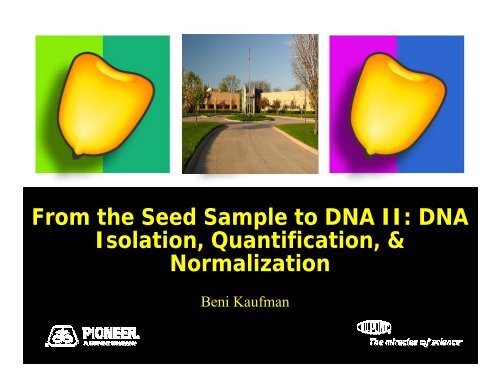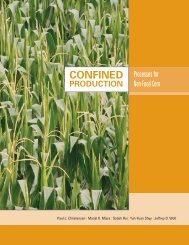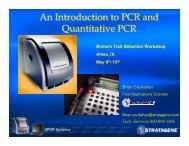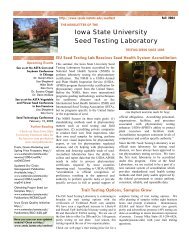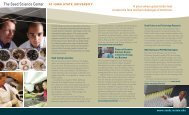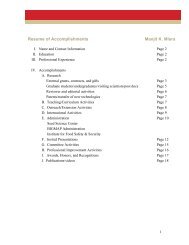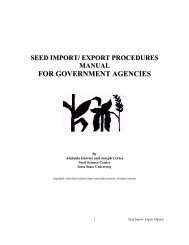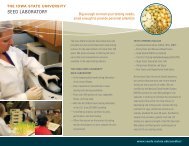The Importance of DNA Isolation
The Importance of DNA Isolation
The Importance of DNA Isolation
Create successful ePaper yourself
Turn your PDF publications into a flip-book with our unique Google optimized e-Paper software.
From the Seed Sample to <strong>DNA</strong> II: <strong>DNA</strong><br />
<strong>Isolation</strong>, Quantification, &<br />
Normalization<br />
Beni Kaufman
<strong>The</strong> <strong>Importance</strong> <strong>of</strong> <strong>DNA</strong> <strong>Isolation</strong>:<br />
Quality <strong>of</strong> <strong>DNA</strong> determines PCR efficiency, hence,<br />
the detectability & sensitivity <strong>of</strong> the test.<br />
PCR efficiency is<br />
affected by the:<br />
concentration <strong>of</strong><br />
impurities:<br />
• Directly; enzyme<br />
inhibitors, or<br />
• Indirectly –<br />
– impurities<br />
binding the <strong>DNA</strong><br />
and effectively<br />
making it<br />
unavailable to<br />
the enzymatic<br />
reaction<br />
PCR<br />
PCR<br />
Set-up<br />
Normalization<br />
Quantification<br />
<strong>DNA</strong> <strong>Isolation</strong>
Also, PCR efficiency is affected by:<br />
• the integrity <strong>of</strong> <strong>DNA</strong> molecules<br />
(length <strong>of</strong> fragments, shredding,<br />
degradation)<br />
• Both impurities and degradation may<br />
affect quantification – throw <strong>of</strong>f<br />
reaction<br />
• <strong>DNA</strong> Quantity defines<br />
representation, and the<br />
contribution to sampling error<br />
THE OVERALL<br />
TESTING SUCCESS<br />
DEPENDS ON <strong>DNA</strong> ISOLATION
Challenges to isolate <strong>DNA</strong><br />
from seed:<br />
– Compared to leaf tissue: Seed<br />
contains much less <strong>DNA</strong> and much<br />
(much) more “impurities”<br />
(carbohydrates, phenols, lipids)<br />
– <strong>The</strong> most labor intensive step<br />
– <strong>The</strong> priciest step<br />
– Throughput bottle neck
Isolating <strong>DNA</strong>…<br />
Grinding:<br />
mechanical breakdown<br />
<strong>of</strong> the cell wall<br />
Dissolving membranes<br />
Pulling out <strong>DNA</strong>,<br />
or impurities<br />
Cleaning…
Grinding<br />
<strong>The</strong>re is no “<strong>of</strong>f the shelf”<br />
grinder suitable for AP<br />
testing…
Grinding<br />
• Effects <strong>of</strong> particle size –<br />
…<strong>The</strong> smaller the better! ☺<br />
– <strong>The</strong> smaller the particle size, the<br />
larger the surface area and the<br />
exposure to the extraction buffer<br />
– and therefore, the more<br />
efficient the extraction…<br />
– Representation <strong>of</strong> the lot<br />
(particles per unit mass)<br />
– Homogeneity <strong>of</strong> the mixture<br />
(particles per unit volume)
Dissolving Membranes<br />
• Lysis by way <strong>of</strong>:<br />
– Detergents<br />
• SDS<br />
• CTAB<br />
– Chaotropic Salts<br />
– Alkaline Lysis<br />
– Other denaturing reagents<br />
Results in a “soup” <strong>of</strong> cellular debris<br />
and the content <strong>of</strong> the cytoplasm.
Pulling Out… Pulling In…<br />
Separate the soluble (<strong>DNA</strong>) from<br />
the insoluble (cell debris) by<br />
way <strong>of</strong>:<br />
– Centrifugation<br />
– Filtration<br />
Purify <strong>DNA</strong> from other solubles<br />
– Organic solvents<br />
– Columns<br />
– Magnetic clearing
Organic Extraction<br />
• Phenol/Chlor<strong>of</strong>orm<br />
– denatures and extracts proteins<br />
• Ethanol/high salt<br />
– Differential precipitation <strong>of</strong> <strong>DNA</strong><br />
Lengthy<br />
Labor intensive<br />
Automation hostile<br />
Safety Issues
• Silica Column<br />
Columns<br />
– <strong>DNA</strong> binds silica in high<br />
concentrations <strong>of</strong> chaotropic salts<br />
– Impurities are washed <strong>of</strong>f<br />
– Eluted <strong>of</strong>f with low ionic strength<br />
solution<br />
– Increased throughput & purity<br />
– Commercial kits<br />
NucleoSpin, DNeasy, GenElute
Magnetic Clearing<br />
• Coated paramagnetic beads<br />
– Silica<br />
– proprietary<br />
– Increased binding<br />
kinetics/efficiency<br />
– Enhanced removal <strong>of</strong><br />
contaminants<br />
– Commercially available<br />
ChargeSwitch, Wizard, MagAttract
Cleaning and Elution<br />
• Alcohol wash to remove salts<br />
and other impurities.<br />
• Elute or dissolve <strong>DNA</strong> in TE,<br />
water, or other low ionic<br />
strength buffer.<br />
Ready for quantification…
Quantification<br />
• Spectrophotometer<br />
– Absorbance at 260 nm<br />
• (UV illuminator)<br />
• Fluorometer<br />
– Hoechst Dye<br />
– PicoGreen
Spectrophotometry<br />
• Concentration = OD 260 * 50 µg/ml<br />
(ds<strong>DNA</strong>) * dilution factor<br />
• Purity<br />
– Measure <strong>of</strong> proteins<br />
OD 260 :OD 280 = 1.8<br />
– Measure <strong>of</strong> phenolics/chaotropic salts<br />
OD 260 :OD 230 > 1.5<br />
– Measure <strong>of</strong> particulates<br />
OD 330<br />
• Simple & non-destructive,<br />
• Narrow range 5 µg/ml to 90 µg/ml,<br />
easy to over estimate due to<br />
contaminates (RNA, ss<strong>DNA</strong>,<br />
nucleotides, phenols, proteins)
Fluorometry<br />
• Detection <strong>of</strong> enhanced<br />
fluorescence upon dye binding<br />
ds<strong>DNA</strong><br />
• Hoechst 33258<br />
– Quantitate to 10ng/ml<br />
• PicoGreen<br />
– Quantitate to 25pg/ml, and less<br />
sensitive to the presence <strong>of</strong><br />
contaminants (RNA, proteins,<br />
detergents)
Input raw fluorescence<br />
values for standards.
Scroll down for the<br />
standard curve.<br />
Input standard curve<br />
information.
Input raw fluorescence<br />
values for unknowns.<br />
Concentrations given<br />
here.
Normalization<br />
• Provides uniformity in testing:<br />
– To comply with the sampling scheme<br />
– To comply with validated<br />
process/assays<br />
• qPCR enables in-assay normalization<br />
but logistically simple to follow<br />
uniform processing<br />
• Enhances robustness <strong>of</strong> testing –<br />
higher success rate, hence, in the<br />
long run reduces cost, and on the<br />
average may improve turn around<br />
time
Volume Initial, Concentration Final,<br />
Concentration Initial<br />
Diluent needed to add to<br />
Volume Initial to give<br />
Concentration Final.
Throughput/Automation<br />
• At isolation, quantification, and<br />
normalization


